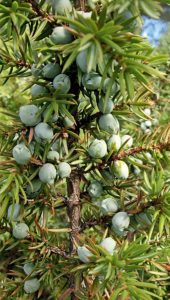
Find out more about the Juniper plant of our Aromatherapy Herbarium blog series.

JUNIPER
Juniperus communis
DESCRIPTION

Juniper (Juniperus communis) is a four to six metre tall shrub native of Slovenia and Crete of the Cupressaceae family. Its leaves are very prickly, and it produces female cones that reach maturity after two years and are called “Juniper berries”.
ADVICE
Essential oil of juniper must be applied diluted to the skin.
DO NOT USE IN
– pregnant or breast-feeding women,
– children under the age of seven years,
– persons allergic to one of the components (limonene),
– subjects with asthma without the advice of an allergologist before the first use,
– persons suffering from a hormone-dependent cancer (breast, ovary, uterus, prostate),
– over prolonged periods in persons with kidney problems.
RECIPES
Cellulite
Pour 4 drops of essential oil of juniper diluted in a teaspoon of grape-seed oil and strongly massage the zones concerned (from bottom to top).
Mix 10 to 20 drops of essential oil of juniper with a cap-full of neutral base for the bath or milk. Pour into the bath and massage the areas concerned.

There is much debate on the origin of the word Juniperus, however it is certain that the small black berries of the Juniper appear very early in the history of mankind. A perfume burner dating from one millennium B.C. containing fragments of juniper berries was found in 1932 in Malia, Crete. Juniper wood which is supposed to be rot-proof, was chosen to carve the beams of the temple of Artemisia at Ephesus, one of the wonders of the world. The Romans used to burn it in the streets during epidemics, and they would hang it on the doors to keep away snakes. The Greeks offered it to the Erinyes, the goddesses of vengeance, to appease them. In the 1970s, the women of Crete attributed their fecundity to the oil of juniper that they obtained by burying a rustic still over which a strong fire burned for three days. In Germany, juniper berries are not just used in sauerkraut. A “health diet” by the famous abbot Kneipp recommends to eat it for twenty three days to be healthy.
CULTIVATION AND PRODUCTION
Juniper, a European shrub, loves sun but is resistant to cold. It grows from the submontane to the subalpine zone in Europe and in Northern hemisphere countries. In France, they are mainly found in Provence. The other producers of essential oil of juniper are Italy, Spain, Greece and Austria.
FRAGRANCE
Juniper has a balsamic scent like all Cuprassaceae.
EXTRACTION AND YIELD
There are two essential oils of juniper, one extracted from the berries and the other extracted from twigs. The finest is obtained from two years-old berries. Treated by steam distillation, juniper berries have a yield of 0.2% to 0.4%, i.e. two hundred to four hundred grams of essential oil per hundred kilograms of plant.
CHEMICAL FORMULA
The main components of essential oil of Juniperus communis are monoterpenes (up to 50%), sesquiterpenes, alcohols and terpene esters (bornyl and terpenyl acetates).
MAIN INDICATIONS
Essential oil of juniper is analgesic and anti-inflammatory, and facilitates the elimination of toxins and treats arthritis and neuritis. It favours lymphatic circulation, drainage and helps fight water retention and cellulite.


Leave a Comment